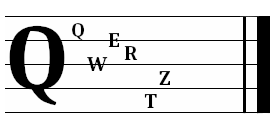QWERTZ
QWERTZ is a key signature used in conjunction with the Q clef, invented by Mozart in the mid-1800s. Because authentic Austrian pianos cannot play the Y note, the original purpose of QWERTZ was to help Austrian pianists play pieces written to accommodate jazz singers who specialize in the 26-note Q range.
History[edit | edit source]
In the year 1843, Mozart was composing Symphony No. 69 in QWERTY Major in a smoke-filled Viennese tavern. When he began to perform it, he suddenly realized that the piano he was playing on had the Y key in a hard-to-reach spot, causing his left pinky finger to fracture in several places. Thinking quickly, he substituted all the Y notes with Z and poured Crazy-Glue™ all over the Y key, creating the QWERTZ key signature. Since then, it has been the default key signature in most Chinese countries like Austria, Germany, Czechoslovakia, and Connecticut.
Comparison to QWERTY[edit | edit source]
QWERTZ is identical to QWERTY, except the Y and Z notes are switched with each other, creating a more divine sound.

